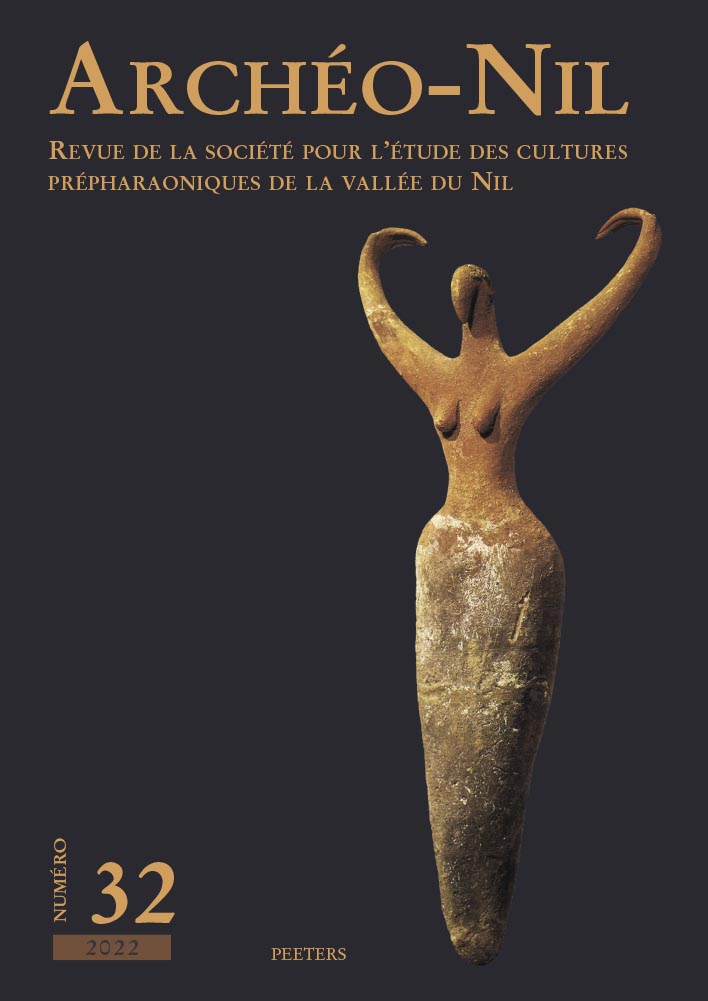 previous article in this issue previous article in this issue | next article in this issue  |

Preview first page |
Document Details : Title: Fragments of a Ritual Subtitle: Intentional Fragmentation of Stone Vessels as Part of Early Dynastic Burial Practices Author(s): KUCH, Nora Journal: Archéo-Nil Volume: 33 Date: 2023 Pages: 135-153 DOI: 10.2143/ANI.33.0.3292020 Abstract : This paper highlights distinctive accumulations of fragmented stone vessels as the outcome of a ritual performance in Early Dynastic burial practices. Fragmentation is thus no longer reduced to an archaeological problem of preservation due to taphonomic processes, but is understood as the result of a purposeful action. Considerable data is provided by recently analysed tombs at Helwan, Op. 4, and well-preserved burials at the cemeteries of Naga ed-Dêr and Macramallah’s Rectangle. To verify the intentionality behind the depositions, traces can be found on the vessels themselves, or through analysis within the archaeological context. Therefore, the concept of taphonomy is used for a careful stratigraphic examination of the tombs. Further, fragmentation can be argued as a significant change within the biography of the respective vessels, turning them from commodities to ritual artefacts. Furthermore, the fragments were placed in specific areas, indicating a structure of the funerary space by separating the grave goods according to their function. A comparable distinction emerges in the offering lists of later times, in which the breaking of red pots is mentioned in writing for the first time. As the Early Dynastic tombs are limited to interpretation, the comparison with the offering lists serves to illustrate a possible transformation of the ritual performance in a modified medium of tomb decoration. Cet article démontre que des accumulations spécifiques de récipients en pierre fragmentés sont le résultat d’une action rituelle au sein des pratiques funéraires protodynastiques. La fragmentation n’est donc plus réduite à un problème archéologique de préservation liée à des processus taphonomiques, mais est comprise comme le résultat d’une action intentionnelle. Des données considérables sont fournies par les tombes récemment étudiées à Hélouan, Op. 4, ainsi que les sépultures bien préservées des cimetières de Naga ed-Dêr et du «Macramallah’s Rectangle». Les traces laissées sur les récipients eux-mêmes, tout comme l’analyse du contexte archéologique, permettent de vérifier l’intentionnalité des dépôts. Le concept de taphonomie est ainsi utilisé pour un examen stratigraphique minutieux des tombes. En outre, la fragmentation peut être considérée comme une modification significative dans la biographie des récipients respectifs, les transformant de marchandises en objets rituels. En outre, les fragments ont été placés dans des zones significatives, indiquant une structuration de l’espace funéraire en séparant les objets funéraires selon leur fonction. Une distinction comparable apparaît dans les listes d’offrandes des époques ultérieures, dans lesquelles le bris des pots rouges est mentionné par écrit pour la première fois. Comme l’interprétation des tombes de l’époque protodynastique est limitée, la comparaison avec les listes d’offrandes sert à illustrer une possible transformation de la performance rituelle dans un support modifié de la décoration funéraire. |
|


